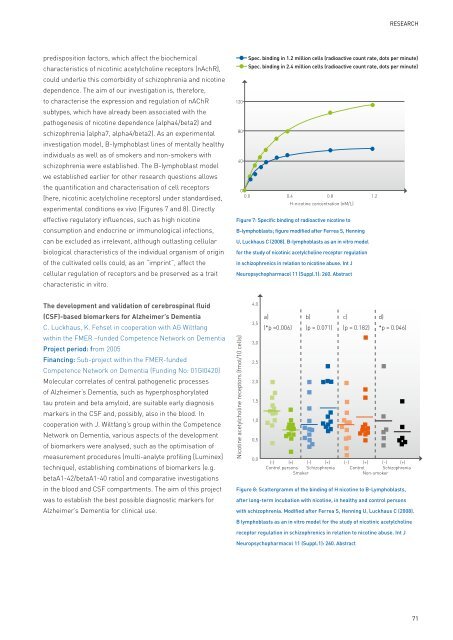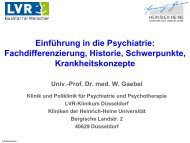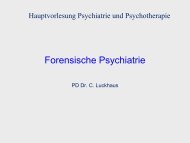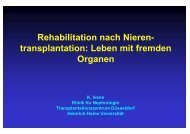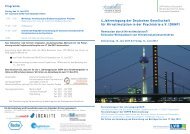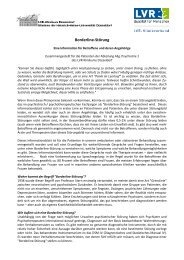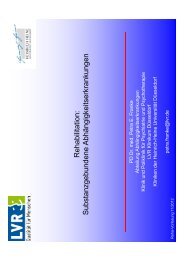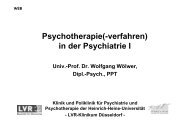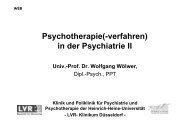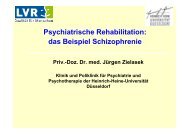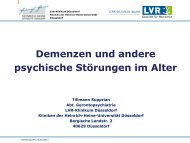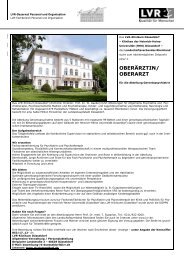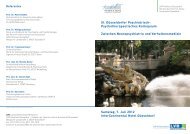LVR-Klinikum Düsseldorf Hospital of the Heinrich-Heine University ...
LVR-Klinikum Düsseldorf Hospital of the Heinrich-Heine University ...
LVR-Klinikum Düsseldorf Hospital of the Heinrich-Heine University ...
Create successful ePaper yourself
Turn your PDF publications into a flip-book with our unique Google optimized e-Paper software.
predisposition factors, which affect <strong>the</strong> biochemical<br />
characteristics <strong>of</strong> nicotinic acetylcholine receptors (nAchR),<br />
could underlie this comorbidity <strong>of</strong> schizophrenia and nicotine<br />
dependence. The aim <strong>of</strong> our investigation is, <strong>the</strong>refore,<br />
to characterise <strong>the</strong> expression and regulation <strong>of</strong> nAChR<br />
subtypes, which have already been associated with <strong>the</strong><br />
pathogenesis <strong>of</strong> nicotine dependence (alpha4/beta2) and<br />
schizophrenia (alpha7, alpha4/beta2). As an experimental<br />
investigation model, B-lymphoblast lines <strong>of</strong> mentally healthy<br />
individuals as well as <strong>of</strong> smokers and non-smokers with<br />
schizophrenia were established. The B-lymphoblast model<br />
we established earlier for o<strong>the</strong>r research questions allows<br />
<strong>the</strong> quantification and characterisation <strong>of</strong> cell receptors<br />
(here, nicotinic acetylcholine receptors) under standardised,<br />
experimental conditions ex vivo (Figures 7 and 8). Directly<br />
effective regulatory influences, such as high nicotine<br />
consumption and endocrine or immunological infections,<br />
can be excluded as irrelevant, although outlasting cellular<br />
biological characteristics <strong>of</strong> <strong>the</strong> individual organism <strong>of</strong> origin<br />
<strong>of</strong> <strong>the</strong> cultivated cells could, as an “imprint”, affect <strong>the</strong><br />
cellular regulation <strong>of</strong> receptors and be preserved as a trait<br />
characteristic in vitro.<br />
The development and validation <strong>of</strong> cerebrospinal fluid<br />
(CSF)-based biomarkers for Alzheimer’s Dementia<br />
C. Luckhaus, K. Fehsel in cooperation with AG Wiltfang<br />
within <strong>the</strong> FMER –funded Competence Network on Dementia<br />
Project period: from 2005<br />
Financing: Sub-project within <strong>the</strong> FMER-funded<br />
Competence Network on Dementia (Funding No: 01GI0420)<br />
Molecular correlates <strong>of</strong> central pathogenetic processes<br />
<strong>of</strong> Alzheimer’s Dementia, such as hyperphosphorylated<br />
tau protein and beta amyloid, are suitable early diagnosis<br />
markers in <strong>the</strong> CSF and, possibly, also in <strong>the</strong> blood. In<br />
cooperation with J. Wiltfang’s group within <strong>the</strong> Competence<br />
Network on Dementia, various aspects <strong>of</strong> <strong>the</strong> development<br />
<strong>of</strong> biomarkers were analysed, such as <strong>the</strong> optimisation <strong>of</strong><br />
measurement procedures (multi-analyte pr<strong>of</strong>iling [Luminex]<br />
technique), establishing combinations <strong>of</strong> biomarkers (e.g.<br />
betaA1-42/betaA1-40 ratio) and comparative investigations<br />
in <strong>the</strong> blood and CSF compartments. The aim <strong>of</strong> this project<br />
was to establish <strong>the</strong> best possible diagnostic markers for<br />
Alzheimer’s Dementia for clinical use.<br />
120<br />
80<br />
40<br />
Figure 7: Specific binding <strong>of</strong> radioactive nicotine to<br />
B-lymphoblasts; figure modified after Ferrea S, Henning<br />
U, Luckhaus C (2008). B-lymphoblasts as an in vitro model<br />
for <strong>the</strong> study <strong>of</strong> nicotinic acetylcholine receptor regulation<br />
in schizophrenics in relation to nicotine abuse. Int J<br />
Neuropsychopharmacol 11 (Suppl.1): 260. Abstract<br />
Nicotine acetylcholine receptors (fmol/10 cells)<br />
4,0<br />
3,5<br />
3,0<br />
2,5<br />
2,0<br />
1,5<br />
1,0<br />
0,5<br />
a) b) c) d)<br />
ReseaRch<br />
Spec. binding in 1.2 million cells (radioactive count rate, dots per minute)<br />
Spec. binding in 2.4 million cells (radioactive count rate, dots per minute)<br />
0<br />
0.0 0.4 0.8 1.2<br />
H-nicotine concentration (nM/L)<br />
(*p =0.006) (p = 0.071) (p = 0.182) *p = 0.046)<br />
0,0 (-) (+) (-) (+) (-) (+) (-) (+)<br />
Control persons Schizophrenia Control Schizophrenia<br />
Smoker Non-smoker<br />
Figure 8: Scattergramm <strong>of</strong> <strong>the</strong> binding <strong>of</strong> H nicotine to B-Lymphoblasts,<br />
after long-term incubation with nicotine, in healthy and control persons<br />
with schizophrenia. Modified after Ferrea S, Henning U, Luckhaus C (2008).<br />
B lymphoblasts as an in vitro model for <strong>the</strong> study <strong>of</strong> nicotinic acetylcholine<br />
receptor regulation in schizophrenics in relation to nicotine abuse. Int J<br />
Neuropsychopharmacol 11 (Suppl.1): 260. Abstract<br />
71


